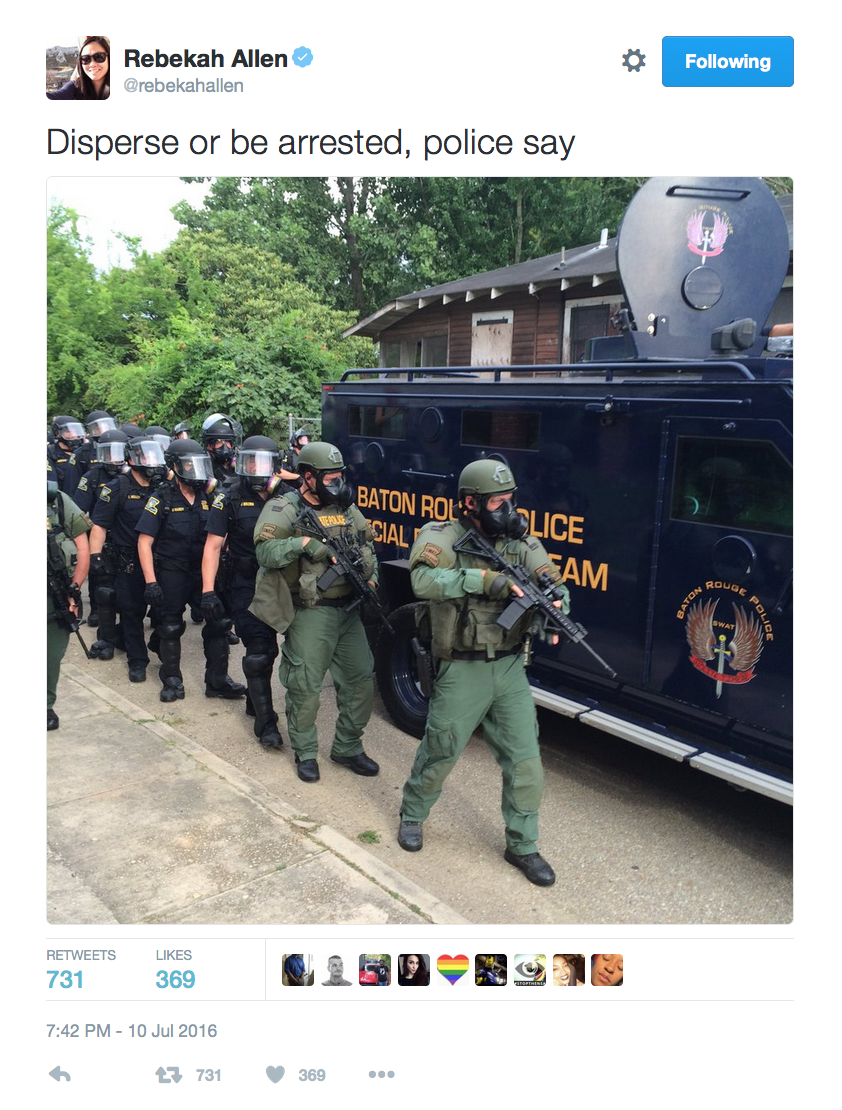Baton Rouge police got military gear through controversial Defense Department program

The militarized response to the protests against a police killing in Baton Rouge got widespread attention on social media. This photo was sent out over Twitter by Rebekah Allen, a reporter with The Advocate newspaper.
The street protests that have taken place in Baton Rouge, Louisiana, since last week's police shooting death of Alton Sterling outside a convenience store have drawn scrutiny in part for the heavily militarized police response.
That militarization can be seen in the iconic image that's emerged from the actions showing Ieshia Evans, a bespectacled protester in a sundress, standing calmly as two officers in full riot gear rush at her with handcuffs as a phalanx of similarly-suited police stand behind them. Police have also deployed armored vehicles during the protests, while National Lawyers Guild observers have witnessed police with their fingers on the triggers of military-style rifles pointed at protesters.
Lisa Batiste, a Baton Rouge resident who allowed protesters to gather in her yard, criticized the conduct of the police, who entered the property to make arrests.
"I'm disappointed. So disappointed," she told The Advocate. "It was extremely unnerving — the military-style policing."
In fact, the Baton Rouge Police Department is using gear initially intended for military use. It is among the many local agencies nationwide that have obtained surplus military equipment through the Defense Department's controversial 1033 program, which came under criticism following the militarized response to protests over the August 2014 police killing of Michael Brown in Ferguson, Missouri.
Facing mounting calls for transparency, the Pentagon in November 2014 released data detailing the tactical equipment it tracks through the program and for the first time identified the agencies that received items. The Marshall Project created a database of the equipment transfers.
It shows that the Baton Rouge Police Department received military gear valued at over $460,000, including a mine-resistant vehicle and 100 5.56-millimeter rifles, which use NATO-standard ammunition. The Louisiana State Police, which has also been involved in responding to the protests, got over $1 million in equipment through the program, including a mine-resistant vehicle, two observation helicopters, four utility trucks, and 176 5.56-millimeter rifles.
Other law enforcement agencies in the area also benefited from the program: The East Baton Rouge Parish Sheriff got equipment valued at over $520,000, including a utility truck, ambulance truck, observation helicopter, and 165 5.56-millimeter rifles, while the East Baton Rouge District Attorney's Office got three 5.56-millimeter rifles.
Launched in 1990, the 1033 program has handed out more than $6 billion in equipment. Of that amount, at least $26 million in gear went to police agencies in Louisiana.
In addition to raising concerns about how the use of military gear affects police departments' relationships with the communities they serve, the 1033 program has sparked questions about how well the high-powered weaponry is tracked. The Pentagon suspended three states from the program — Alabama, North Carolina and Minnesota — for failing to comply with inventory requirements, and it has suspended or permanently banned numerous departments over missing weapons issues.
In May 2015, President Obama announced new limits on the 1033 program. However, a Pentagon spokesperson noted that the policy changes would have little effect as they targeted mostly equipment that wasn't being transferred anyway.
On Sunday, Amnesty International sent an open letter to the Baton Rouge police department urging it to respect the rule of law when dealing with protesters.
"We would remind you that police authorities are required to act in accordance with international human rights standards and the U.S. Constitution," the letter read.
Tags
Sue Sturgis
Sue is the former editorial director of Facing South and the Institute for Southern Studies.
